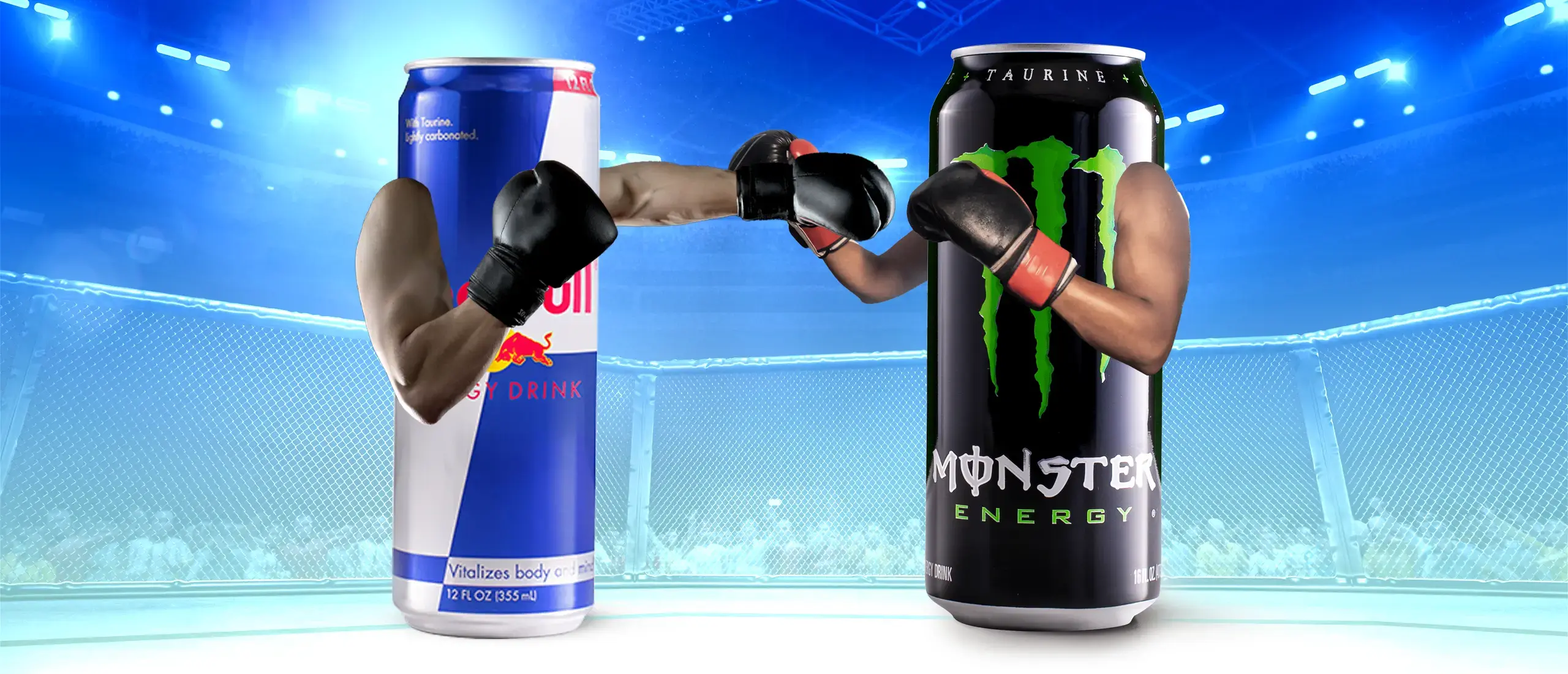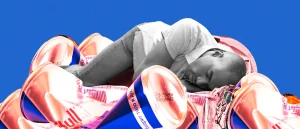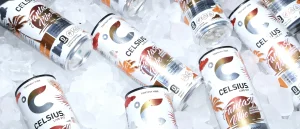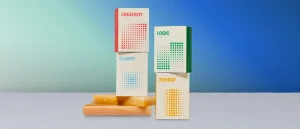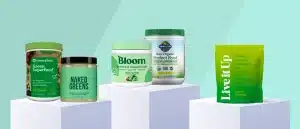Red Bull vs. Monster: Which Is Better for You?
10-Second Takeaway
Let’s be clear—Red Bull and Monster energy drinks aren’t great for your health when consumed frequently. They contain a lot of sugar and caffeine, which can be harmful if you consume too much of them. However, after reviewing the famous brands ingredient and nutritional makeups, we believe Monster is the better choice.
Our product recommendations are selected by editors, tested first-hand, or expert-approved. We may earn a commission through links on our site.
Energy drinks are a popular go-to beverage for a quick energy boost—but they aren’t the healthiest (1), even though some are healthier than others. Red Bull and Monster are two of the most popular energy drinks globally, collectively sharing an enormous percentage of the energy drink market. But which is better for you, and why? After reviewing the ingredients, nutritional facts, and taste, we think the answer is probably Monster. More on that to come.
Unsurprisingly, the United States is the largest consumer of energy drinks (2). We drink them as a nice pick-me-up before school or work to improve our attention and focus. As you chug down these drinks, do you ever wonder what the heck you’re drinking and if it’s good for your health?
Red Bull and Monster are two of the most popular energy drink brands on the market, but how do they compare regarding ingredients, nutrition, and taste? Here’s what you need to know.
Our Experience
Hone Health is a team of health-obsessed journalists, editors, fitness junkies, medical reviewers, and product testers. To ensure we deliver you research-backed information on energy drinks, we’ve spoken to a registered dietitian nutritionist and reviewed several research studies and well-respected medical pages.
About the Expert:
Chrissy Arsenault is a registered dietitian for Training Academy, a certified personal trainer academy dedicated to providing personal trainers better, more science-backed information on training.
Energy Drinks: What to Know Before Buying
While no one should consider energy drinks healthy, certain ingredients can be good for your health. “Energy drinks contain vitamins B1, B3, B3, B6, and B12,” says Chrissy Arsenault, RDN, a registered dietitian for Training Academy. “B vitamins are water-soluble, so anything your body doesn’t need is excreted in urine instead of stored in the body.”
Part of what makes energy drinks work are the many sugars—which, if consumed in large amounts, can harm your health (3). “Consuming too many foods and drinks with added sugars can contribute to health problems, such as weight gain and obesity, type 2 diabetes, and heart disease,” Arsenault says.
Most would likely consider Red Bull and Monster the “top dogs” in the energy drink market. These brands have loyal fanbases who swear by these drinks, but which is the better option?
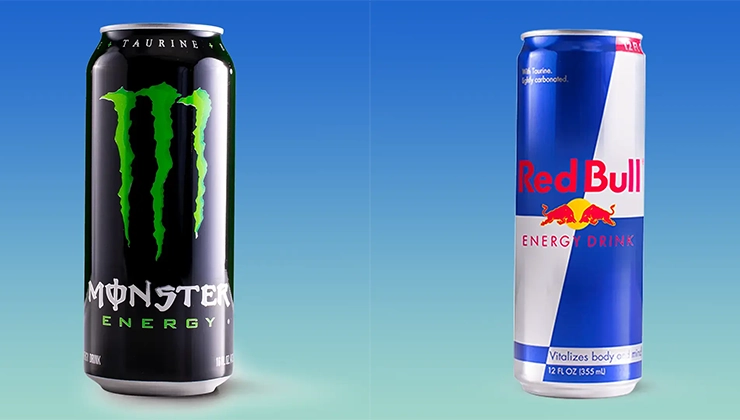
Ingredients
Red Bull
Below are the ingredients you can find in a can of Red Bull (4):
- Caffeine
- B vitamins
- Sugar
- Glucose
- Taurine
- Citric acid
- Carbonated water
- Magnesium carbonate
- Sodium bicarbonate (baking soda)
- Natural and artificial flavors
Magnesium carbonate: Magnesium carbonate is an ingredient unique to Red Bull. It is a type of magnesium salt primarily used for relieving digestive symptoms like indigestion, heartburn, gastroesophageal reflux disease (GERD), and constipation (5). That said, in this case it’s likely included in the makeup of the drink to counterbalance the flavor of the citric acid.
As always, be aware that there is such a thing as too much magnesium—more than 400 mg for men may cause unpleasant side effects, such as diarrhea, nausea, and stomach cramps (6).
Sodium bicarbonate (baking soda): Sodium bicarbonate is just a fancy way of saying baking soda. This ingredient has benefits similar to magnesium carbonate in relieving heartburn, sour stomach, and acid indigestion (7), and it’s also occasionally used by athletes to recover faster.
According to the U.S. Food and Drug Administration (FDA), the daily recommended value of sodium carbonate for adults is 2,300mg (8). Consuming more than the recommended amount may lead to health problems like nausea, vomiting, and abdominal pain (9).
Monster
Here are the ingredients for Monster (10):
- Caffeine
- Taurine
- Inositol
- B vitamins
- L-carnitine L-tartrate
- Carbonated water
- Sugar
- Glucose
- Citric acid
- Sodium citrate
- Sorbic acid
- Benzoic acid
- Sucralose
- Salt
- D-glucuronolactone
- Guarana extract
L-carnitine L-tartrate: A key ingredient in Monster is l-carnitine l-tartrate. This dietary supplement has antioxidant properties that can prevent exercise fatigue and muscle weakness (11). If you’re seeking better athletic performance and recovery, the recommended daily amount of this ingredient is about 1,000 to 4,000mg, based on how intense your workouts are (12).
And, of course, there are downsides to consuming too much of this ingredient. Taking more than 3g (or 3,000mg) of l-carnitine l-tartrate per day may cause nausea, vomiting, abdominal cramps, diarrhea, and a fishy body odor (13).
Guarana extract: Guarana extract is another standout ingredient in a Monster energy drink.“[Guarana extract] is a plant-based caffeine source used in energy drinks,” Arsenault says. A 2021 research review reveals that guarana extract may improve brain function by increasing memory, alertness, and attention. However, it is important to note that many of the studies analyzed guarana in combination with other dietary supplements and exercise (14).
Some people with plant allergies may consider avoiding this drink.
“I’ve seen some clients who are allergic to guarana, so be cautious if you’re adding energy drinks [to your diet] for the first time,” Arsenault says. In addition, high doses of guarana (more than 1,000mg per day) may lead to tremors, jitteriness, agitation, confusion, high blood pressure, and dehydration (15).
Ingredients Winner: Monster
We chose Monster because the energy drink has a few more dietary supplements that can improve your brain function and recovery from physical activity. That said, it’s very close.
Nutrition
Red Bull
Here is the nutritional value of a 16-fluid-ounce Red Bull:
- 210 calories
- 151mg caffeine
- 0g total fat
- 190mg sodium
- 54g total carbohydrates
- 51g total sugars (including added sugars)
- 0g protein
Calories: Compared to Monster’s whopping 298 calories, one Red Bull contains just 210 calories. While both are high in calories for a single beverage due to the high sugar content, Red Bull is the slightly better option.
Caffeine: Red Bull contains a lower amount of caffeine than Monster. “Caffeine is well known for helping to support energy levels,” Arsenault says. Aside from an energy boost, drinking 40 to 200mg of caffeine may also increase alertness and decrease tiredness and reaction time (16).
However, you might want to limit yourself to one Red Bull a day. “Many energy drinks, especially if you’re drinking several in a day, often exceed the daily recommended amount for caffeine, which I usually cap at 400mg for my clients,” Arsenault explains. Drinking more than 400mg of caffeine per day may lead to restlessness, insomnia, headache, nervousness, fast heartbeat, and frequent urination (17).
Monster
Here are the nutritional facts for a16-fluid-ounce Monster drink:
- 298 calories
- 182.4mg caffeine
- 0g total fat
- 230mg sodium
- 72g total carbohydrates
- 66g total sugars
- 2g protein
- 48mg potassium
Protein: A key nutrient within a Monster is protein. As you may or may not know, protein helps your body repair cells and create new ones (18). For our athletic folks, protein plays a significant role in muscle growth. According to the American College of Sports Medicine (ACSM), endurance and strength athletes must consume at least 1.2 to 1.7g of protein per kg of body weight to increase muscle mass (19).
Though extremely unlikely, if you consume more protein than your body needs, you may experience health problems such as bad breath, dehydration, digestive problems, extra calories, foamy or bubbly urine, and kidney issues (20).
The ideal amount of protein for the average, sedentary adult is 0.8 grams of protein per kilogram of body weight. (21).
Potassium: A Monster provides a decent amount of potassium. Potassium is an essential nutrient for nerve and kidney function and muscle contraction. The recommended daily amount for men is 3,400mg (22).
If you exceed your potassium limit, you risk developing hyperkalemia or high potassium. Hyperkalemia can cause symptoms like muscle weakness, numbness, nausea, and tingling (23).
Nutrition Winner: Monster
Despite Monster having more essential nutrients, we’ll go with Red Bull, which has fewer calories, caffeine, and added sugars.
Taste Test
Red Bull
Despite its popularity, Red Bull doesn’t have the greatest taste. Some people compare the energy drink’s flavor to licorice, while others claim it tastes like cough syrup. Aside from a plain Red Bull or the “original” flavor, you can choose from several flavors, including Watermelon, Tropical, Strawberry Apricot, Coconut Berry, Blueberry, among others.
Monster
A Monster may appeal more to your tastebuds, as it resembles a soda, such as a Mountain Dew, with a bit of citrus and fizziness. However, some people feel that it has a funny aftertaste. This energy drink is also available in several flavors, such as Green, Pipeline Punch, Juicy Mango, Pacific Punch, and so on. Monster and Red Bull are about the same regarding increased energy, so you’ll likely feel a boost within 10 to 15 minutes after drinking one.
Taste Test Winner: Monster
If you’re looking for an energy drink that doesn’t have a funny taste—neither of these drinks is right for you. However, we tend to think Monster’s higher sugar content and carbonation makes for a better drink.
References
-
Alsunni, A.A (2015). Energy drink consumption. https://www.ncbi.nlm.nih.gov/pmc/articles/PMC4682602/#
-
Statista (2024). Per-capita volume sales in the energy drinks market worldwide, by country in 2023. https://www.statista.com/forecasts/1274837/worldwide-per-capita-consumption-energy-drinks#
-
Gillespie, K.M., Kemps, E. et al (2023). The impact of free sugar on human health–a narrative review. https://www.ncbi.nlm.nih.gov/pmc/articles/PMC9966020/
-
Red Bull (n.d.). Red bull energy drink ingredients. https://www.redbull.com/us-en/energydrink/red-bull-energy-drink-ingredients-list
-
Hillier, K (2007). Magnesium carbonate. https://www.sciencedirect.com/topics/chemistry/magnesium-carbonate#
-
National Institutes of Health Office of Dietary Supplements (2022). Magnesium. https://ods.od.nih.gov/factsheets/Magnesium-HealthProfessional/
-
Mayo Clinic (2024). Sodium bicarbonate (oral route, intravenous route, subcutaneous route). https://www.mayoclinic.org/drugs-supplements/sodium-bicarbonate-oral-route-intravenous-route-subcutaneous-route/description/drg-20065950#
-
U.S Food and Drug Administration (FDA) (2021). Sodium in your diet. https://www.fda.gov/media/84261/download
-
Hughes, A., Brown, A. et al (2016). Hemorrhagic encephalopathy from acute baking soda ingestion. https://www.ncbi.nlm.nih.gov/pmc/articles/PMC5017849/
-
Monster (n.d.). Behind the claw—Monster energy drink ingredients. https://www.monsterenergy.com/en-us/energy-drink-info/
-
National Cancer Institute (n.d.). L-carnitine l-tartrate. https://www.cancer.gov/publications/dictionaries/cancer-drug/def/l-carnitine-l-tartrate
-
Sawicka, A.K, Renzi, G. et al (2020). The bright and the dark sides of L-carnitine supplementation: a systematic review. https://www.ncbi.nlm.nih.gov/pmc/articles/PMC7507632/
-
National Institutes of Health Office of Dietary Supplements (2023). Carnitine. https://ods.od.nih.gov/factsheets/Carnitine-HealthProfessional/#
-
Torres, E.A., Pinaffi-Langley, A.C. et al (2021). Effects of the consumption of guarana on human health: a narrative review. https://ift.onlinelibrary.wiley.com/doi/epdf/10.1111/1541-4337.12862
-
LiverTox: Clinical and Research Information on Drug-Induced Liver Injury (2023). Guarana. https://www.ncbi.nlm.nih.gov/books/NBK589113/#
-
Walter, K.W. (2022). Caffeine and health. https://jamanetwork.com/journals/jama/fullarticle/2789026
-
MedlinePlus (2021). Caffeine. https://medlineplus.gov/caffeine.html
-
MedlinePlus (2023). Protein in diet. https://medlineplus.gov/ency/article/002467.htm
-
The American College of Sports Medicine (2015). Protein intake for optimal muscle maintenance. https://www.acsm.org/docs/default-source/files-for-resource-library/protein-intake-for-optimal-muscle-maintenance.pdf
-
Cleveland Clinic (2023). Yes, you can definitely eat too much protein. https://health.clevelandclinic.org/can-you-eat-too-much-protein
-
Harvard Health Publishing (2020). When it comes to protein, how much is too much? https://www.health.harvard.edu/nutrition/when-it-comes-to-protein-how-much-is-too-much
-
National Institutes of Health Office of Dietary Supplements (2022). Potassium. https://ods.od.nih.gov/factsheets/Potassium-HealthProfessional/
-
National Kidney Foundation (n.d.) Hyperkalemia (high potassium). https://www.kidney.org/atoz/content/what-hyperkalemia#what-causes-hyperkalemia


